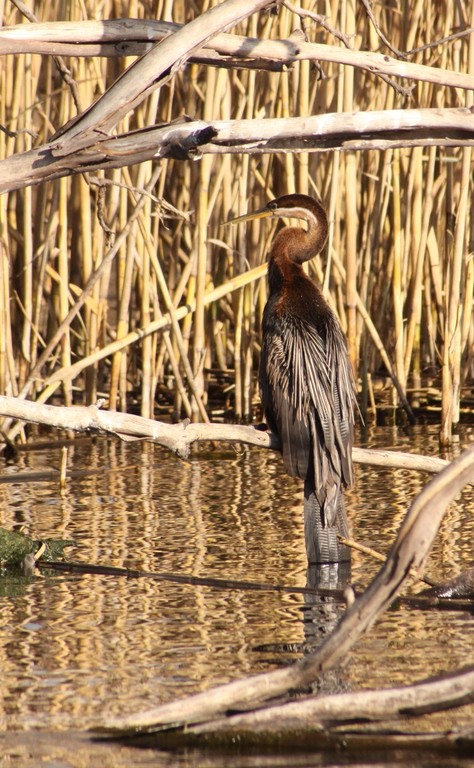African Darter
A species of Darters and Anhinga Scientific name : Anhinga rufa Genus : Darters and Anhinga
African Darter, A species of Darters and Anhinga
Botanical name: Anhinga rufa
Genus: Darters and Anhinga
Content
Description General Info
Description
The male is mainly glossy black with white streaking, but females and immature birds are browner. The African darter differs in appearance from the American darter most recognisably by its thin white lateral neck stripe against a rufous background colour. The pointed bill should prevent confusion with cormorants. It is an 80 cm long cormorant-like fish-eating species with a very long neck, like other anhingas. 
Size
97 cm
Life Expectancy
16 years
Nest Placement
Tree
Feeding Habits
African Darter primarily consumes fish like Cichlidae and Cyprinidae, varying by location. Its diet also includes amphibians, water snakes, terrapins, and aquatic invertebrates. Distinguishingly, african Darter spears prey underwater without active chase and has no specific hunting time.
Habitat
The african Darter typically inhabits still and shallow freshwater environments, including lakes, rivers, swamps, and reservoirs, with a preference for areas that have emergent trees or dense vegetation nearby. These birds can also be found in estuaries, tidal inlets, and coastal mangroves and lagoons, often surrounded by forested margins or islets. They favor environments where they can perch and dry their wings after diving.
Dite type
Piscivorous
General Info
Feeding Habits
Bird food type
Behavior
This species builds a stick nest in a tree and lays 3–6 eggs. It often nests with herons, egrets and cormorants. It often swims with only the neck above water, hence the common name snakebird. This, too, is a habit shared with the other anhingas. Unlike many other waterbirds the feathers of the African darter do not contain any oil and are therefore not waterproof. Because of this, the bird is less positively buoyant and its diving capabilities are enhanced. After diving for fish, the feathers can become waterlogged. In order to be able to fly and maintain heat insulation, it needs to dry its feathers. Thus the African darter is often seen sitting along the waterside spreading its wings and drying its feathers in the wind and the sun along with cormorants which may share its habitat. 
Distribution Area
The African darter is found throughout sub-Saharan Africa wherever large bodies of water occur; overall the species remains widespread and common. One subspecies, the Levant darter (Anhinga rufa chantrei), occurred at Lake Amik (Amik Gölü) in south-central Turkey, in Hula valley lake and marshes in northern Israel and in the Mesopotamian Marshes of the lower Euphrat and Tigris rivers in southern Iraq. The Turkish population disappeared during the 1930s and the Israeli population during Hula drainage in the 1950s. It was feared that it also had disappeared from Iraq, but a small and threatened population remains at least in the Hawizeh Marshes (part of the Mesopotamian Marshes), which are also home to numerous other waters birds such as little grebe, pygmy cormorant, marbled teal and sacred ibis. 
Species Status
Not globally threatened.
Scientific Classification
Phylum
Chordates Class
Birds Order
Gannets and Relatives Family
Darters Genus
Darters and Anhinga Species
African Darter 